MARYLAND GLASS CORPORATION
Baltimore, Maryland (1907-1980)
“M inside a circle”
Maryland Glass Corporation of Baltimore first used the “M in a circle” logo in 1921, according to trademark information reported in Arthur G. Peterson’s 400 Trademarks on Glass (1968). However, Julian Toulouse, in Bottle Makers and their Marks (1971, page 341) wrote that the “M in a circle” first appeared on bottles in 1916. Toulouse’s information appears to be incorrect and the year 1921 actually saw the beginning of the use of this mark.
Maryland Glass Corporation was organized in 1907 as a vehicle for making large quantities of Bromo-Seltzer bottles for parent Emerson Drug Company, of Baltimore. Emerson Drug Company (founder and president, Issac E. Emerson, 1859-1931) had been formed in about 1887 and was officially incorporated in 1891. Emerson was actually a native of North Carolina but had moved to Maryland in 1880, starting a small drugstore in Baltimore not long afterward.

Bromo Seltzer was first sold in about 1888. With greatly increasing sales as the years passed, by the early 1900s Emerson realized he needed a more reliable source of supply for the large quantities of glass bottles needed, so he decided to have his own glass factory built to accommodate the increasing demand. Isaac Emerson teamed up with Philip I. Heuisler to run the Maryland Glass Company operation.
The president of Maryland Glass Corporation was Philip I. Heuisler; Joseph F. Hindes was listed as vice president and treasurer; Parker Cook, secretary, and Harry J. Williams was manager (this info from an invoice dated November 26, 1913- relayed to me by MGC researcher Ernie Dimler).
This company eventually specialized in producing all kinds of cobalt blue bottles and jars, not just Bromo-Seltzer. Many of the blue glass containers made for Phillips Milk of Magnesia, Bromo-Seltzer, Bromo-Caffeine, Vicks VapoRub, Noxzema, Posner’s, Evening in Paris perfume, as well as many other products were produced here. Maryland also produced some clear glass as well as cobalt.
It is virtually certain that the great majority of cobalt blue glass containers made for distribution in the United States during the 1920s-1950s were made by Maryland Glass. Lesser amounts of cobalt container ware were made by Carr-Lowrey Glass Company, also located in Baltimore, and Hazel-Atlas Glass Company.
ADVERTISEMENT
The “M in a circle” mark is seen on tremendous numbers of glass containers from the 1920s through the 1970s, and cobalt blue jars and bottles from trash dumps of this time period are often found that bear this mark. Many of these containers might be classified as “generic” bottles, and have no identification or brand markings other than the “M in a circle” on the base, often accompanied by a mold number.
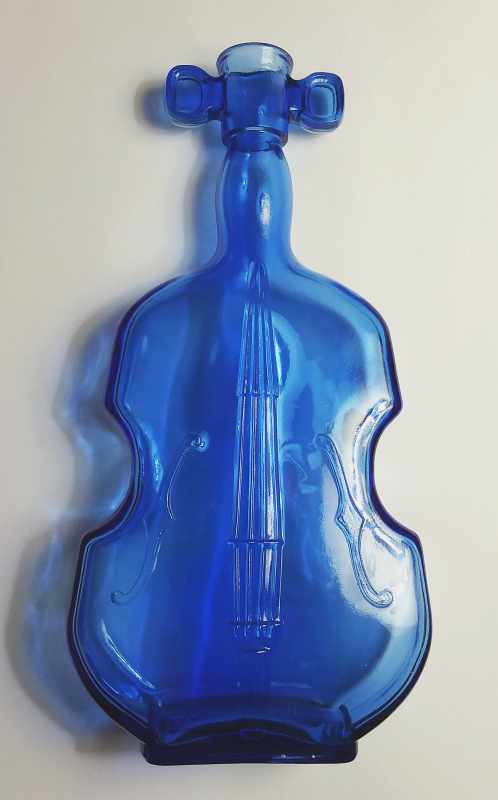
Maryland produced the most commonly-seen type of figural “violin bottle” or “fiddle bottle”, in cobalt blue, amber and clear glass. Cobalt blue is the most common color seen. These bottles were not usually marked, except for bearing a mold number on the bottom. They were probably produced mostly in the 1950s, and were sold in retail outlets such as the typical “five and dime stores” of that era. They were evidently sold in great numbers and are often seen for sale in antique malls and online auction sites.
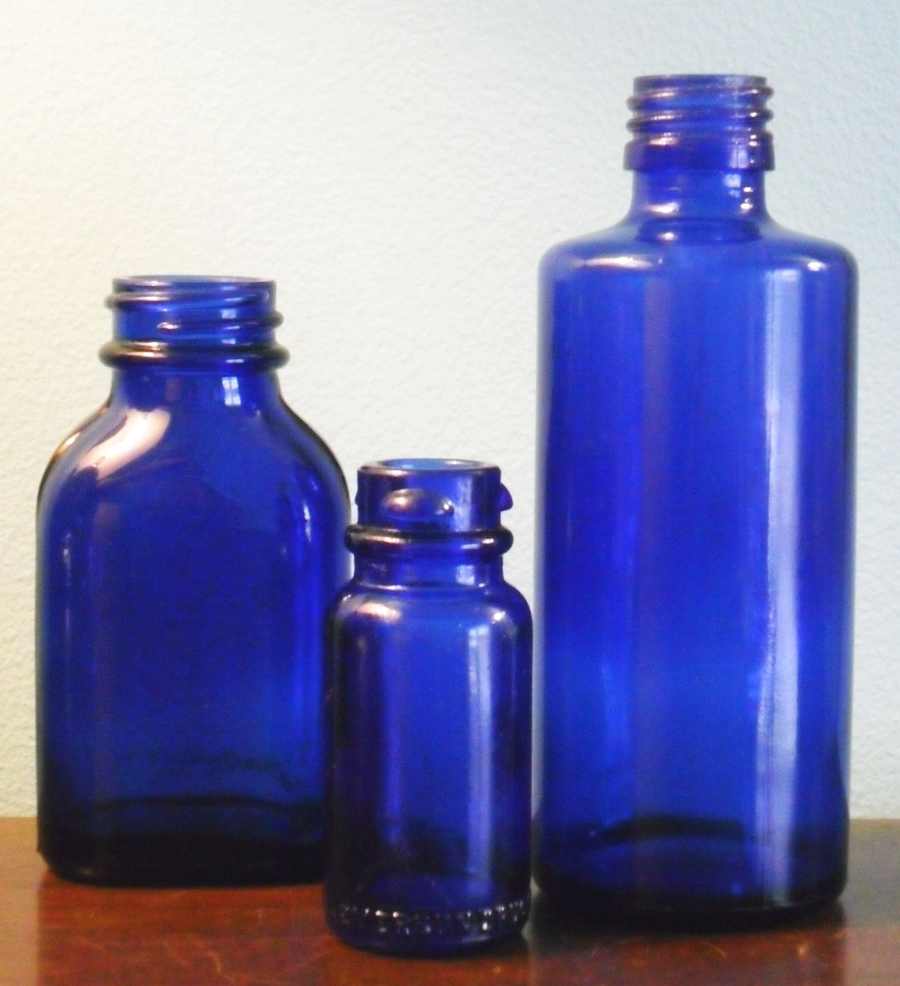
Maryland Glass was acquired by Warner-Lambert Corporation in 1956, and then by the Dorsey Corporation (based in Chattanooga, Tennessee) in 1968. The Dorsey Corporation already had as a major subsidiary the Chattanooga Glass Company which it had acquired in 1960.
The Gulfport Glass Company, of Gulfport, Mississippi, was built in 1955 and was basically a subsidiary of Maryland Glass. A lot of cobalt container ware was also made at the Gulfport facility and was marked with “G in a circle”.
Maryland Glass Corporation continued to operate under it’s own name through the years, even after being bought (successively) by Warner-Lambert and later by Dorsey Corporation (subsidiary of Chattanooga Glass Company). In 1978 the plant was sold by Chattanooga Glass to Steve Kelly, who soon ran into financial problems with the property and filed for bankruptcy in 1979. By 1980 the workers were being laid off, and the plant was closed down completely by February of 1981. The very last bottles were evidently produced in late 1980.
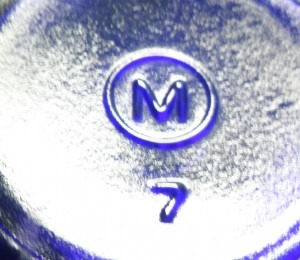
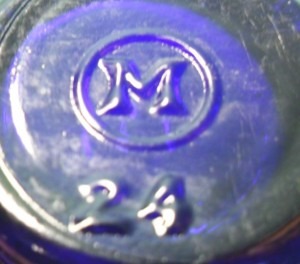
ADVERTISEMENT
OTHER MARKS
Maryland also used a “plain M” mark on some bottles, including Phillips Milk of Magnesia bottles, such as pictured below.
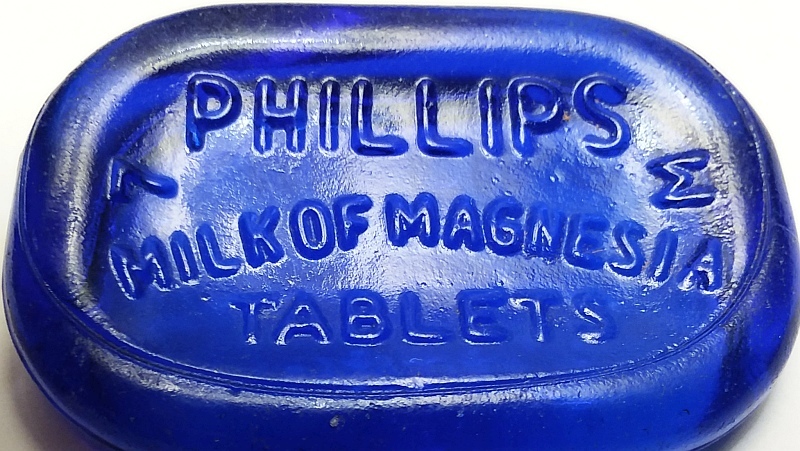
Rarely, Maryland Glass used an “M inside a G” logo, shown here as seen on the base of a rectangular poison or medicine bottle. The exact period of time the “M inside a G” mark was used is uncertain but it might date from rather early in the company’s history.
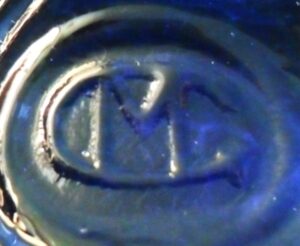
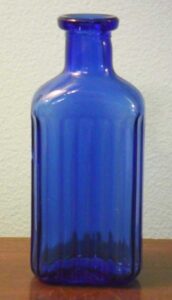
NOTE: An “M in a circle” logo is also seen on the base of tableware, novelty glass shoes, upscale reproduction pattern glass, various colored glass toothpick holders, etc, and in those cases it is the mark of an unrelated firm, the Mosser Glass Company of Cambridge, Ohio. (Maryland Glass made, for the most part, utilitarian and commercial containers.)
Please click here to go to the Glass Bottle Marks section (page 4).
Click here to go to my website Home Page.
For more information on the Bromo-Seltzer bottles, the most well known product of Maryland Glass Corporation, see my webpage here: Cobalt Blue Bromo Seltzer Bottles
Bromo Seltzer Arts Tower
NOTE: I wanted to heartily recommend this museum in Baltimore where hundreds of bottles made by Maryland Glass, as well as a variety of other items related to the company including letters, calendars, invoices, advertisements and other ephemera are displayed. The collection, curated by Maryland Glass historian and collector Ernie Dimler, is displayed on the 15th floor of the Bromo Seltzer Arts Tower (or “Bromo Tower”) in downtown Baltimore. For more information, check out this site:
https://www.bromoseltzertower.com/visitor-info/museum
Here is an article with a short video of Ernie, showing some of the glass in the museum:
Maryland Glass Museum – Ernie Dimler
ADVERTISEMENT

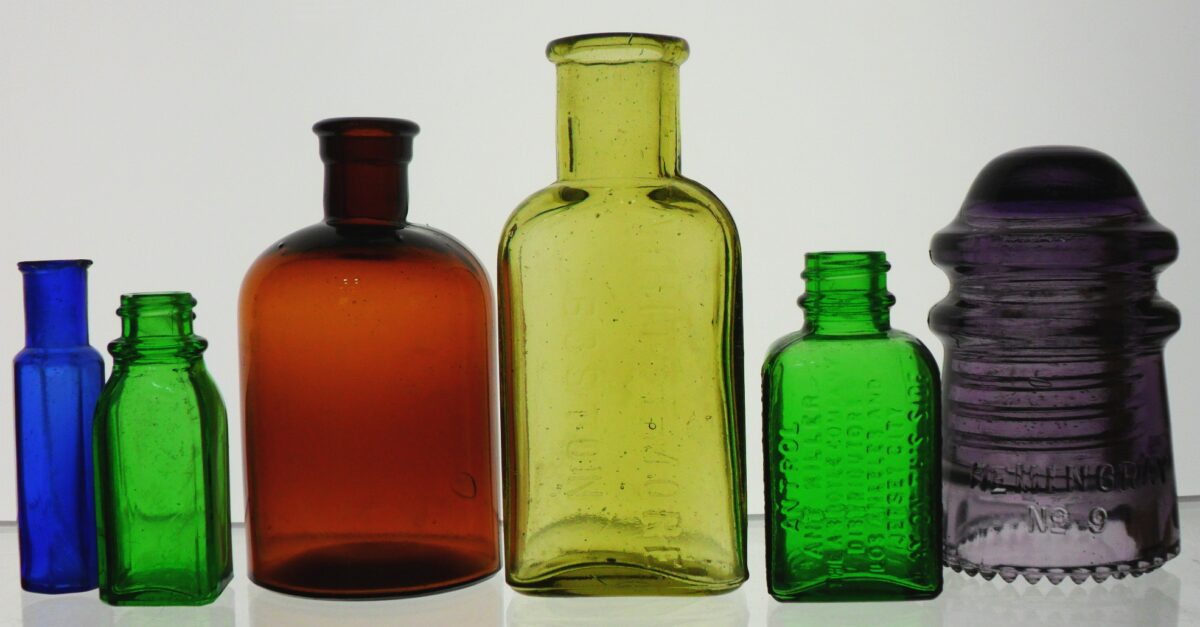
What about a cobalt blue vase with an M circled on the bottom? Any idea on what time period it was from?
Hi Lori,
I can’t tell you with certainty, as a number of vases were made by Maryland over the years. But the “M in a circle” trademark was used beginning in 1921 and possibly continued to be used all the way up into the 1970s. I don’t know exactly when the mark was last used – it may have been used on some bottles up to the very end of the Maryland Glass operation in 1980, but, to be honest, I am not sure.
Thanks for your post!
~David
I have a MD liquor bottle with what appears to be a shot glass built into it. It is stamped Pat Pending for R724 with 30-51 as well. I assume that means it was produced in 1951 but I have not been able to find any other information on it.
Hi Danah,
From your information I can only tell you that the “R” number is a “Rectifier” identification number, and the “30” is a liquor bottle permit number that was assigned to Maryland Glass Corporation of Baltimore. And yes, 1951 would be the year that Maryland Glass made the bottle. I’m sorry but I’m not familiar with the bottle. You might try contacting Ernie Dimler, who is a researcher on Maryland Glass Corporation, and has a museum exhibit in the Bromo Seltzer tower in Baltimore. He might be familiar with the bottle you describe.
Best regards,
David
I found a clear glass bottle with an M inside a circle, but there are other markings. It says, RONO 36 above the M, and DESIGN PAT. 57178 below the M, and then at the bottom, and “I”. It’s clear, so I don’t think it’s a Milk of Magnesia bottle. The dump site in the middle of the woods would probably date this around 1940-1960. Any ideas what this bottle might have contained?
Hi James,
Go to the “Google Patents” website, type in the search bar “D57178” and see if there are any bottle-related results. I don’t know anything about what the “RONO” could be referring to.
David
On the blue violin or cello bottle all there is is a number 2 with an oval shape inside the square bottom.
Valerie,
The violin bottles made by Maryland Glass Corporation were evidently not marked with their “M in a circle” trademark, but (as far as I know) only carry a mold number on the bottom such as the “2” that you see on your bottle.
Thanks for your post, David
What about m in a circle with a 3 ?
Hi Mickey,
Many Maryland bottles with the “M in a circle” mark on the bottom also include a single or double-digit number. The “3” is a mold number, identifying the particular mold the bottle was made in.
David
My understanding is that plastic screw caps debuted in 1927. Does anyone know if/when MD Glass started using them?
I am also curious for any clues to dating screw top bottles from Maryland Glass. Found a triangular 8 inch blue bottle embossed Norwich on the shoulder. I assume 30s or 40s but imagine it could also be more recent. Appreciate any insight on this particular bottle.
The Gulfport glass company was built by the MD. Glass Corporation; therefore it was part of the MD Glass Corporation.
Gulfport was part of the Chattanooga Glass Co. I believe it came about in 1960, Bill Burke worked at Gulfport. He was an employee of Maryland Glass Corp in Baltimore. He talked of a re-build after a flood. Contact me David.
Ernie
I have a Phillips milk of Magnesia bottle with genuine Phillips and Made in the USA on the bottle. the #16 on one side with a circled C on the other. I’m trying to figure out what the circles C is. for I haven’t been able to find any other Phillips bottle with that on it only Gs and Ms. any info would help thanks
Hannah,
I am not sure about that mark. If it is truly a “C in a Circle”, the bottle may have been made by Chattanooga Glass Company, which did use that trademark for many years. However, Chattanooga was primarily known for their soda bottles such as Coke. Perhaps they did make the Phillips bottle? There is also a possibility that the mark is actually intended to be a “G in a circle” which would be Gulfport Glass Company. Gulfport made many of the Phillips Milk of Magnesia bottles in blue glass.
David
I have a blue bottle with Emerson Drug Co Bromo Seltzer, it has the M, but a 9, and, what is the significance of the number, is it age related, what is base related. I also have the cap which twists on, does it really matter?! Thanks
Hi Mac,
The number “9” is a mold number and doesn’t give us any information on age. Since the lid is a screw-type, I would imagine the bottle dates from sometime from the 1920s or later. It is difficult to date these bottles precisely.
~David
David,
I’ve seen a mention of an X above the M in the circle a couple times. I have one with a 1 below the M (assume mold #). Do you know what the X means? Does it say anything about what was in the bottle? Thanks, John
John, I don’t know for sure what it means, but I am guessing it is a mold identifier.
David
I recently found a dump site loaded with bottles from the early 1950’s. Two bottles are Maryland Glass with Sharp & Dohme lids. The bottles are the same shape but one is a lighter blue, very smooth bottom with circle M and 10 below. The other a deep blue with a stippling ring around the base. It has the circle M with 5 below but the 5 is turned sideways.
I read in this thread the stippling was added ~1945. I wonder how long it was used. Also, the only bottles I’ve seen like this from Sharp & Dohme contained an antiseptic. Any additional information would appreciated.
Ernie, i have a flat sided cobalt blue bottle with a weird metal top. I found the bottle also on ebay but not with the metal cap. Wondering what it was used for? Bottom has Des Pat 109513 and R.D.NO.82. Thank you for any information you may have.
Hey David! I found the base of a cobalt bottle in Hawaii. Above the m in a circle is the letter X. Below the M is the number 2. Google didn’t provide me with much insight. Thanks for your help!
Hi Jennifer,
Maryland Glass Corporation made huge numbers of cobalt bottles and jars over many years, and I don’t have specific info on many of them. If you wish, you might email me a pic of the bottle (address on far lower left of any page) and I will see if I recognize the general type. Often, a certain shape will identify what product was most likely contained inside.
Best regards, David
My father worked there for 30 years until a fake investor group came in town, purchased the company STOLE his pension and many others now he barely survives off of SSI…..DOES anyone have the history on this purchase OR who stole this money? I would love to find out……I still have many bottles from there both brown and blue glass, violens, and others……
My Grandfather worked at this plant his whole life and came from a family of glass makers. He raised 18 children all born of the only wife he ever had.
Hi Richard,
Thanks for your post. There is so much interesting history behind any glass company and the people who worked there and made the glass.
If I may ask, what was your grandfather’s name?
Best regards,
David
I have a Blue Cobalt Bear with the M in a circle and the #1 under the circle. Can you tell me what year it was made?
Debbie, I assume you have a small Mosser Glass Company bear figurine in cobalt blue glass? The “M in a circle” mark on the bottom would be referring to Mosser Glass Company, not Maryland. (Please see my alphabetical list of “M” marks).
In any case, I do not know what year the various bear figurines were made. I would assume that each color was poured for a short period of time, and records were kept on which colors were made when…….but I don’t have that information. Perhaps a reader will direct us to an online source if that information is available. Thanks for writing,
David
There was a cobalt bear bottle that was produced by Maryland Glass Corp for the Frank Tea and Spice co,now called franks red hot sauce.The bear was a hot sauce bottle.embossed spicy bear
It was asked several times in the thread but I did not see an answer – is there a list of what the mold numbers correspond to? I have 2, 4, 5, 17 etc. Bromo, vicks and noxema I can identif. But two I have no idea what they are for.
Hi Kim,
I’m not positive I understand your question, but here goes………
Modern automatic glass bottle machines each have a number of bottle molds (mold cavities) installed on the machines……anywhere from 6 to 10 or 12 (or sometimes more) and each mold is numbered. There may be more than one machine in the factory going at once, so the numbers may go over 12.
Also, molds / mold parts will gradually wear out over time, and new ones are introduced into production. In a sense, the numbers don’t really “mean” anything, but they are just a simple way of identifying the molds on each machine, so in case any problems come up with the bottles, the relevant mold can be identified.
On a machine with 12 molds (“mold cavities” or “mold assemblies”), the molds might be numbered 1 through 12. Or 13 through 24.
Check out this youtube video about making glass bottles.
https://www.youtube.com/watch?v=A_M8WBJMcM0
If you look closely at the video, at about 1:30 it shows an individual mold (mold cavity) installed on a machine. There would be a number (or numbers) engraved somewhere on the inside of the mold, either on the inside “heel”, or the base plate, or both, and that is what you may see on the surface of the finished bottles.
Of course, there are many different types of modern automatic bottle machines, and some of the bottles you find are much older, and the machines they were made on would be a lot different than the high-tech machines used nowadays.
Have you seen my webpage about numbers on the bottom of glass bottles? I have some info there too. I am sorry as I know a lot of this is confusing. I don’t even understand all of it myself, but just the basics.
I hope this helps a bit.
Best regards,
David
It’s joe again my email is jenkinsbiker55@aol.com
Hello My name is Joe Jenkins. I am the one who worked there for 41/2 years and my mother for 34 years and her name was Frances Elizabeth Jenkins and nickname was (Tunne).
Hi I’m looking for permission to print some of these pictures for a magazine article.
Rebecca, if you could, just please give credit by mentioning the name of this site…… GlassBottleMarks.com and/or the webmaster, David Whitten. Thanks!
David
Is it an article about Maryland Glass ? What kind of publication ? I am the Curator of the Bromo Seltzer and Maryland Glass Museum rooms at the Bromo Seltzer Tower in Baltimore.And maybe I can add some info to your research,I am finding new things on Bromo Seltzer & Maryland Glass on a daily basis.
I will contact you ty Ernie Dimler ,Curator,Conservator.
Hi my name is Tom Cochran Jr. My father worked there for over 35 years. I have very many Maryland glass bottles in my home. Including the heisler bottle ,Also several more bottles made for employees only . I also have several mold sample bottles with their original paper labels attached .As well as a Maryland glass postcard from about 1912/1913. I can post pictures or you can contact me @ tecflyer1@yahoo.com
Thomas, I sent you an email and have not received a reply. Please check your spam/trash folders.
~David
I am grateful to be able to add to the science of bottle identification TY, Ernie Dimler,Curator,Conservator.
You are correct, partially, Heuisler family ran Maryland Glass, Isaac E Emerson was the chairman Executive committee, Philip I Heuisler, president, Joseph F Hindes, Vice President and Treasurer, Parker Cook, Secretary, Harry J Williams is Manager. This is what is listed in a Maryland Glass Corp Invoice dated November 26 1913, Home Offices listed at Bromo Seltzer Tower Building with Mt Winans listed as the Works. Maryland Glass was a collaboration between Issac E Emerson and Philip I Heuisler, specifically for making Bromo Seltzer bottles in the beginning, later making cobalt for many other companies like Sharp and Dohme as early as the 1920s, Evening in Paris, Milk of Magnesia, Noxzema, Vick’s, along with flasks produced in the 1970’s.
I have the Maryland Glass bankruptcy papers here in our collection. According to employees, the last glass bottles were made in 1980, the lawsuit continued till the 80s when bankruptcy was final. Some employees had individual suits for Insurance Claims for medical bills never paid, It was ugly at the end when employees would race to the bank, worried about not enough money in bank for all checks. I am meeting Ann Heuisler tomorrow, there is no telling what I will learn. Ernie
No government bail out for The Glass industry, which put a lot of people in financial horror. Everything tastes better from glass containers. Plastic and tin can not compare.
If the bottle is cobalt blue it is likely something from evening in Paris perfume,or possibly nail polish remover from the 1950’s to 60’s. Send pic to site please.
Hi David, just spoke to Louis Demely who worked at MD glass for 24 years and was friends with Phillip Heuisler the 3rd super at the plant. Maryland Glass history at the end/The first buy out was by the Warner Lambert co in 1956. After this buyout the plant changed for the worse according to Demely,
Chattanooga Glass purchased Maryland Glass Co from Lambert Pharmaceutical; Chattanooga glass sold to Dorsey Trailer Co in 1979. I have the anniversary bottle in our collection from Chattanooga from 1978 when it was made. Dorsey took over in 1979 and the last glass bottles were produced in 1980 according to Bill Burke 40 yrs, MD glass, Louis Demely 24 years, and countless others who are listed along with their job they did— Mold maker , Drafting etc. The Owens machines came in 1914 according to paperwork I have from 1914 receipt. Machine was bought from Hazel Atlas, M in a circle was started in 1921 when the transition from cork to lugs took place, the corkers with M in circle are some of the last corkers made, I have only seen 1. It is in our collection at the Bromo Seltzer Tower along with over 500 items Bromo, Emerson related. We now have about 500 Maryland glass pieces in our collection, also Receipts, bottles, ephemera etc. Hope this helps nail down how the ending of Maryland glass came about. Ernie Dimler, Curator, Bromo Seltzer Tower Museum and Maryland Glass expert. We are visiting with Ann Heuisler on Fri – I will keep you informed about my research.
Ernie,
I really appreciate the info you’ve passed along! Good stuff!
Take care, David
Hi Ernie,
Also, just a quick note, I found a bit of info embedded in this webpage (pertaining to a lawsuit involving Maryland’s pension plan) that the furnaces were shut down permanently on February 25, 1981. Do you have any idea if bottles were continued to be made right up to the very last day the furnaces were lit? http://law.justia.com/cases/federal/district-courts/FSupp/618/1410/1793751/
~David
Wow that is great stuff, ty for sharing.
David Whitten, My findings after years of research looking at over 5,000 cobalt blue bottles [test subjects] every day. Specifically looking for Maryland Glass artifacts for our museum room. I also have interviewed about a dozen Ex-Maryland Glass Corp employees. I have concluded that once puzzling bottle marks from Maryland Glass can now be deciphered, we know for a fact that Bromo Seltzer bottles from OB Co and AB Co bottles can be definitely be dated precisely to 1904 and 1905, but not made by Maryland Glass Corp. The 1908 to 1911 blown Bromo Seltzer bottles can be precisely identified as Maryland Glass, because of numbers on the bottom. These identifiable markings, numbers, are to tell what mould needed to be replaced when the embossings become faint, as there were many other companies also making Bromo Seltzer Bottles in this same period.
Remember, Maryland Glass Corp was started because Ohio and American Bottle company could not keep up with production in 1904 and 1905. Just think, American Bottle could produce beer bottles by the millions and could not keep up. The receipts in our collection first mention the bottle machine in 1911 when Hazel Atlas mentions the purchase of a bottle machine to make flint inks in 1911. It is thought that this is possibly a Hailey Bridgewater machine that leaves a small round circular scar on the bottom of the bottles. This mark is seen on first machine made Bromo Seltzer bottles produced around 1911 to 1915.
The first Owens machine is mentioned in 1914 when you can see the Owens ring on the bottom along with a mould number and sometimes an X or I mark with a mould number, some Milk of Magnesia specimens have an M on the bottom and also mould numbers or just a mould number also.
The Maryland Glass Corp bottles produced with the Owens machines after 1914 are definitely identifiable. Other companies that produced cobalt bottles in this period were always marked. Hazel Atlas never not marked their glassware. Pieces produced by Owens or Illinois glass, or Whitall Tatum, Carr Lowrey were also identifiable with their own glass marks, these companies were some of the largest producers of bottles in the country also producing some cobalt pieces all marked.
Maryland Glass Corp produced 90% of all cobalt bottles in United States by 1930s.
The M in a circle was first used in 1921 and was still used in 1975, cobalt Jax Beer bottle in our collection, made by Bill Burke when he worked at Maryland Glass Corp in 1975, has 75 also on bottom.
The C in a circle was also used at Maryland Glass when the company was purchased by Chattanooga Glass Co in 1960. I have now identified over 400 different Maryland Glass Corp pieces.
With the machine made Dodge and Olcott, Owens machine made pieces being identified as Maryland Glass Corp also, with a typical Owens ring and mould number.
The M in a circle Bromo Seltzer were first used on the last Owens machine produced cork bottles 1920-21,and all lugged bottles produced between 1921 and 1952 also have the M in a circle.
In 1953 we first identified a continuous thread bottle first seen in magazine articles. The first continuous thread bottles, where the cap was used for dosing, have the M in a circle on them with a mould number.
In 1956 the M in a circle was dropped when Warner Lambert purchased the company and went from a cap-full to a teaspoon full and a stippled edge was seen on the bottom with a Mould number. The first stippled bottom was first seen in 1948 in the bottle pictured.
The changes in Bromo Seltzer bottle dating and identification during the period of Maryland Glass Corp can be used to date other cobalt bottles also produced by Maryland Glass Corp.
I also believe that the early Brooklandwood bottles are also made by Maryland Glass Corp with the first time used M inside a G. These bottles were only produced 1 or 2 years, possibly 1914 to 1916 and could be a first attempt at producing something other than Bromo Seltzer bottles at the Maryland Glass plant. An M inside a diamond was also used on flint glass eye cups. There were many variations of the M in a circle that was used , M could also be different sizes depending on mould used. Each mould maker could have used his own distinctive marks.
Ernie, thanks a lot for the additional information, I appreciate your posts!
David
Hi! This is great information! I can’t say I know anything about glass, but I found a bottle while hiking that was interesting looking enough for me to bring home and clean off. I don’t think it is too old, or maybe it is not really old at all, but still an intriguing piece to me. It is a clear bottle that measures just shy of 4 inches in height. There is an “M” in a circle on the bottle with the number “2” below it. All sides are patterned – kinda lighting bolts and sun rays in an art deco type of style. The number “62” is on the neck. I appreciate any help or information!
Lalinda, I don’t know about the bottle, but will approve your post for publication. Perhaps someone might run across this comment and know more about it. You could also email me a pic (my email address is at the bottom right-hand corner of any page on this site).
~David
Excellent! Looking forward to working with you.
Jim
UDELE, your bottle is a common Medicine bottle with measurements, this could be anything from citronella oil to cod liver oil, Henry K Wampole also used these for Cod Liver Oil, These also have the M in a circle on the bottom.
How did you like our Maryland Glass and Bromo Seltzer collection Jim Coyle ?
How can I contact you Ernest? I’ve been reading your articles on Maryland Glass. I have a white bottle that is crackled glass and marked M inside a circle. I can’t find another that looks like it. I would love to send you a picture.
I have a clear glass bottle. M in a circle and a 7 on the bottom. There is an odd 3iii on the front wider flat side. It is skinny 5in tall. 2″x1″ Rectangular jar. Rounded corners in the back with front two corners “sliced off” to make 3 flat sides on the front of the bottle. It would have had a cork. No screw top markings. Any idea what it could have been used for at one time?
Hi Udele,
You have a “generic, all-purpose” pharmaceutical/druggist bottle. For more info on the “weird 3” symbol, check out my reply in the “Comments” section of this webpage: https://glassbottlemarks.com/bottlemarks-4/. Please scroll down to my post (replying to Karen, written on July 27, 2013). Many readers ask about this “odd 3” marking which appears on many older druggist bottles. They were made by many glass bottle manufacturers, yours being a product of Maryland Glass Corporation.
Hope this helps!
David
I was born and raised directly across the street from The Maryland Glass Corp. The Heisler Family owned that company. My parents started a lunch room type of business and it grew into the neighborhood Pub of Mount Winans. Our family business which lasted over four decades became a meeting place for glass factory workers and neighbors. I later worked there in the office. I have many blue glass bottles including the famous Bromo Seltzer ones and the fiddle ones. I own two complete sets of the Bicentennial Bottles. Each bottle shows a scene from the Revolutionary War.
Elizabeth email me at tecflyer1@yahoo.com I am Tommy Cochran Jr. My mom and us worked there for some time at the pub.
My Uncle made a lot of the molds for the glass bottles etc. I also had cousins and Uncles who were operators. My Uncle Albert was head of the Glass Workers Union. A cousin was sent to Gulfport MS if needed down there because he was an expert operator and troubleshooter. My grandfather came to America from England because he was a glass blower and was hired before his arrival at Carr-Lowrey Glass Company. My Uncle Joe made the crown bottle mold for Prince Matchabelli Perfume. I know an awful lot about these Glass Factories. I worked in the office of The Maryland Glass Corporation which was located across the street from my parents’ business. I am proud of my heritage reflecting back to the greatness of American Industrial Age.
My father and all of my siblings worked for MD Glass at some point or another. They were all Hoover’s, Charles (Charlie or Buzz); Barry; Patrick; John; Shirley. My dad frequented the pub I’m sure. Did you happen to know any of them?
please contact me at pooltableman17@msn.com
Yes, Sorry.
jim
David,
I am coming to visit this Saturday.
Jim
Jim, I am assuming your message is intended for Ernie, referring to the Maryland Glass room in the Bromo Seltzer Arts Tower.
~David
I am Curator of the Bromo Seltzer Building Collection, We have over 100 Maryland Glass Cobalt Blue pieces at the Bromo Seltzer Arts Tower. We are now working on our Maryland Glass room, with over 500 Maryland glass pieces, including Maryland Glass Documents, Paperwork and over 100 cobalt blue pieces all from Maryland glass ,including Piggy, owl, bear, sea horse, fiddle bottles, cigarette holders, flasks, noxema, bromo, milk of magnesia, sharp and dohme, poison bottles, just to name a few. The M in a circle was first used in 1921 when the first lugged bottles were used according to calendars with pics of lugged bottles that are dated here at the Tower. The piggy was made in 1950 to 1951 according to Bill Burke who worked there for forty years, who is my go-to expert. My father also worked at the Bromo Tower for 12 years from 1955 to 1967.
Thanks a lot Ernie for your information!!
~David
Thanks for clarification.
Looks like David has given you what you needed. There was a period in the early 1900’s when the MD Blue Glass did not have the “M” on them. So it makes it difficult to clearly identify every cobalt blue glass item as MD Glass. I have been researching to see if someone wrote a catalogue on all the MD Glas products; unfortunately I have not found this.
My father worked there from 1929 to 1969; his entire career.
Jim
My son just gifted me a cobalt blue MG Co. bottle. I understand the circle M mark, but I have questions about the other marks. Over the ‘M’ the letter ‘L’. Under the ‘M’ is ‘Design PA’ (the D looks more like an ‘O’,but that doesn’t seem to fit, and I can not find a Design PA on the map so far. Under this mark are the numbers ‘97178’, and under that the number ‘5’. I assume the 5 is a mold mark.
Help
Joseph Haley
Tallahassee FL
Hi Joseph,
Not sure about the “L”. but the other markings mean “DESIGN PATENTED” (by the United States Patent and Trademark Office) and the patent number of that particular bottle design which is D97178. I searched the “Google Patents” site and found this: (The bottle design was patented in 1935). https://patents.google.com/patent/USD97178S/en. Hope this helps!
~David
I have pictures of some products,I have of Md.Glass, cobalt blue,if anyone is interested I can be reached at. glenfromberlin1934@hotmail.com
Glen,
Thanks for your note. Glad you have an interest in the Md. Glass Corp materials. I have collected most of the various bottles they made; my focus is on the specialty items they made which were given as gifts to customers and friends.
Jim coyle
does anyone know of a site i can go on that I can look up pieces? I have a set of ruby footed cut glasses and I’m trying to find out the name of them. I took a book out of the library titled “GLASS OF CUMBERLAND MARYLAND AREA” by Dale Murschell. They were in there, thats how I know they are by Maryland Glass, but there wasn’t any style name. Please email me at Dianevgi@aol.com if you know where I can find these. I usually don’t go on the internet so much, so I probably won’t go on this site again, so an email would be great. Thank you for any help you can give me.
Hi Diane, I am posting your query here. Perhaps a reader will contact you with more information. I tried to find Dale L. Murschell’s current contact information online without success. There is someone by that name who lives in West Virginia but it may not be the same person.
I am sure the ruby footed glasses you refer to were not made by Maryland Glass Corporation. I do not have a copy of Murschell’s book; however, from my understanding, his book concentrates on glass factories located in the Cumberland, Maryland area (Allegany County). Maryland Glass Corporation (subject of this webpage) was located in Baltimore (Baltimore County). The Maryland Glass Company of Cumberland, Maryland was unrelated to Maryland Glass Corporation of Baltimore. Maryland Glass Corporation made primarily (not exclusively) container glass. Maryland Glass COMPANY of Cumberland apparently made tableware, not bottles.
Best regards,
David
David…thank you….I guess I will have to go back to the library and check other books for these glasses 🙂
Hi Diane, just to make sure I’m making myself clear………….if those exact glasses ARE illustrated in Dale Murschell’s book on the glass of Cumberland, Maryland, then I would suggest you just need to contact Mr. Murschell and see if he has any more info about the pattern name, values, etc. (As far as I know he is still alive, but I don’t know that for sure.) I strongly doubt you will find the glasses shown in any other books. Would you be able to email me a pic of the glasses? Please send to my email address which is listed under “CONTACT INFO / NOTES” near the bottom of any page on this website.
Best regards, David
Thanks for the technical info about 1921. That helps with identifying pieces after that.
Jack,
My father got a chemistry degree from Loyola College in 1929. He went to work at MD. Glass as a chemist. A fellow Loyola classmate was the son of the Corp. President, Phil Heisler. he worked there til his death in 1969, rising to the position of Superintendent of Glassmaking.
the M on the products came about around 1930. But not all products had the symbol on them. many of their gift items were unique and not produced in large quantities. I think there most famous gift was the blue glass violin bud vase. I have been attempting to collect these gift items over the years. at the Bottle Club exhibition this past Spring, I found an item I was not aware of made in the early 1930’s. It is a blue glass ashtray with the Md Glass name and M on the bottom and identified as a Christmas gift. It looks like a flat tea bag holder with a Ladle handle. It was dated 1934.
I have been searching for the blue glass piggy banks that they produced in the late 1940’s into the 50’s. Since they did not have an escape hatch, they likely were broken to retrieve the coins.
I wish that someone had catalogued all of their products from the beginning of the seltzer bottles.
Jim
Jim, the cobalt blue glass piggy banks sound beautiful and adorable, and I would guess that occasionally one of them shows up on ebay! I’m sure a few people kept them as keepsakes, or for decoration and didn’t store coins in them, and so never felt the need to break them! At least I certainly hope so!!! Also, I’m not trying to pick an argument with you, but according to Arthur G. Peterson’s reference book “400 Trademarks on Glass” (1968) the “M inside a circle” was used beginning in 1921. His information came from researching the actual United States Patent & Trademark Office records, so I assume it is correct (or at least, that is assumedly the information that was supplied to the government office by Maryland Glass Corporation when they applied to have their trademark officially registered).
Best regards,
~David
The piggy was produced in 1950 to 1951, We just added one to our collection, it is one of my favorites..
Hello to all you “posters” – I sent this to Jim initially, but realized many of you may have stories to tell or things to share. I work for the Baltimore Museum of Industry. I am unofficial in asking, but could you relate the “story” of Maryland Glass for me sometime? I would love to take notes. Do you have an “artifacts”? Many thanks, Jack Burkert – burkert.jack@gmail.com
Wanda,
That is great! Maybe someone could start a MD. Glass Corp. Alumni group. It could be a subset of the Baltimore Bottle Club.
I am surprised by how little has been researched and written about the MD. Glass Corp since it was a major company in Baltimore for 70 years. For example, I can’t find a written catalog of all the products and gifts they made all those years. My knowledge is from my memory as a son of a 40 year employee.
Jim
Jim, I work for the Baltimore Museum of Industry. I am unofficial in asking, but could you relate the “story” of Maryland Glass for me sometime? I would love to take notes. Do you have an “artifacts”? Many thanks, Jack Burkert – burkert.jack@gmail.com
My Pappy, Charles Knickman, his sons, my father Maynard Knickman, and my uncle Sonny Knickman worked at Maryland Glass all their lives. I still have some pieces my Dad brought home. A colbalt blue top hat, a ringed vase and a violin. At my childhood home in Elkridge we had one of the machines Pappy made. I don’t know what happened to it. I do have a copy of the blue prints. I believe Pappy was a glassblower in his early years.
Glen,
My father, Thomas Coyle, worked there for over 40 years, ending as Superintendent of glassmaking. Do you know where any others of the cigarette jars may be available for purchase? secondly, did anyone ever catalogue all the various bottles and jars that the company made over the years?
I wish there were a more documented history of the MD Glass Co.
jim
I worked for me. Glass corp for22 yrs.i had the cigarette holder you speak of,in addition to the fish and crabs it also has Maryland my Maryland on it. On the bottom it has Christmas 1932. I was a mold maker there, my son now has the cigarette, humidor,. My name is Glen Mullins
My Dad passed last year and yes i do have the cigarette humidor and several other beautiful decanters he gave me in our curio cabinet.
Great! You are fortunate to have the holder. They are more rare than other items.
I am inquiring to see if anyone knows what the #s under the M trademark stumble stand for?
Randall, usually, the single or double-digit numbers along with the “M in a circle” trademark are mold numbers— identifying the mold which was used to make the item.
~David
Among the specialty bottles they made was a very unique cigarette holder; it was a blue jar, similar in size to a Noxema jar, with a fish, crab and lobster embedded in the glass. It also had a divider with a silver top to hold the cigarettes. If anyone has seen such an item, I would be pleased to know.
My grandpa worked at Maryland Glass for 50 years, also his sons and daughters were lifelong employees. When I was a child, I helped Pappy build machines in the extra bedroom which he gave to to company and significantly increased quality and production. My grandfathers name was Charles Henry Knickmen. TY. Ken Huffman 540-718-8111
Hi Ken, and thank you for the information! I’m posting this on the page, so perhaps others with a family history relating to Maryland Glass could contact you. ~David
Jim my name is Glen Mullins. I was a mold maker at md.glass corp. for 22 yrs,I had the cigarette humidor you speak of.my son has it now.i could probably send you a picture of it.
Glen,
Please let me chime in as well………..if you see any info here on my site that you believe is in error, please feel free to contact me. I would like to have my webpage on Maryland Glass (as well as my pages on other glass companies and topics) as accurate as possible. I realize there is A LOT that is not known, or at least not published, about glass and glass companies, so bottle researchers just go by the best info available. Take care and thanks for your input.
~David
Glen,
That would be great for my records. Thanks.
Jim I have the pictures if you would email me. I would send them to you.
Will do. I think your email us on the membership list of Bottle Club.
Jim
I can be reached at. glenfromberlin1934@hotmail.com if anyone else who has connections with Md glass corp would like those pictures fool free to contact me,
I used to work there. For 41/2 year then I got layed off. My mother worked there for 34 years. I have a Glass Bottle with the owners picture on it.
Joseph,
I hope you knew my Father, Tom Coyle. He was the Superintendent of the Plant in his later years there.
That is the Heuisler bottle from 1972 that was only given to employees.Then the molds were destroyed according to Bill Burke 40 yr employee.
We have one at the Bromo Seltzer Arts Tower Museum room, on the 15th floor along with 15 floors of great art and artist studios. We have 2 in our collection. These are real hard to find items.